Unlock the secret to healthier eating with homemade cauliflower rice. This incredibly versatile, low-carb, gluten-free, Keto, and Paleo-friendly food serves as an impeccable side dish for virtually any wholesome meal, helping you boost your vegetable intake without sacrificing satisfaction. Say goodbye to carb-heavy grains and embrace a delicious, nutrient-dense alternative that’s easy to prepare and incredibly flavorful.

What is Cauliflower Rice? Your Ultimate Low-Carb Grain Alternative
Cauliflower rice is a revolutionary culinary staple that transforms a humble head of cauliflower into a grain-like consistency, mimicking traditional rice. It’s an ingenious way to incorporate an extra serving of vegetables into your diet while significantly cutting down on carbohydrates. For those adhering to specific dietary plans such as Keto, Paleo, Whole30, or simply aiming for a healthier lifestyle, cauliflower rice acts as a perfect, guilt-free substitute for white rice, brown rice, or even couscous.
Beyond its low-carb appeal, cauliflower rice boasts an impressive nutritional profile. It’s rich in essential vitamins and minerals, including Vitamin C, Vitamin K, and folate, and offers a good source of fiber, which aids digestion and promotes satiety. Its mild flavor makes it incredibly adaptable, allowing it to absorb the flavors of any dish it accompanies, from vibrant stir-fries to hearty curries and fresh grain bowls. While pre-riced cauliflower is readily available in most grocery stores, making it at home is not only more economical but also allows you to control the texture and freshness, ensuring the best possible result for your meals.
Mastering Homemade Cauliflower Rice: Two Easy Methods
Making your own cauliflower rice from scratch is surprisingly simple and much more rewarding than buying pre-packaged versions. Freshly prepared cauliflower rice often has a better texture and taste, avoiding the sometimes watery or overly soft consistency of frozen or pre-riced options. All you need is a fresh head of cauliflower and a few minutes of your time. Before you begin, always wash your cauliflower thoroughly and pat it dry to remove excess moisture, which can lead to a mushy texture.
Method 1: Using a Box Grater for Perfect Texture
The box grater method is a classic and effective way to achieve a rice-like texture, especially if you don’t own a food processor. It provides a slightly coarser grain, which can be desirable for certain dishes.
- Preparation: Start by thoroughly washing the head of cauliflower. Remove all green leaves and trim the tough core.
- Quarter and Section: Carefully split the cauliflower head in half, then cut each half into two large quarters. This makes the cauliflower much easier to handle and grate safely.
- Grating Technique: Using the large holes of a standard box grater, firmly rub each quarter of the cauliflower against the grater. Work slowly and carefully, paying attention to your fingertips. Continue grating until the cauliflower breaks down into small, rice-sized pieces. Repeat this process with all remaining florets until the entire head is transformed.
- Even Consistency: You may find some larger pieces remaining. Simply re-grate these pieces to ensure a uniform consistency. This method gives you excellent control over the final texture, allowing for a perfectly “riced” result.
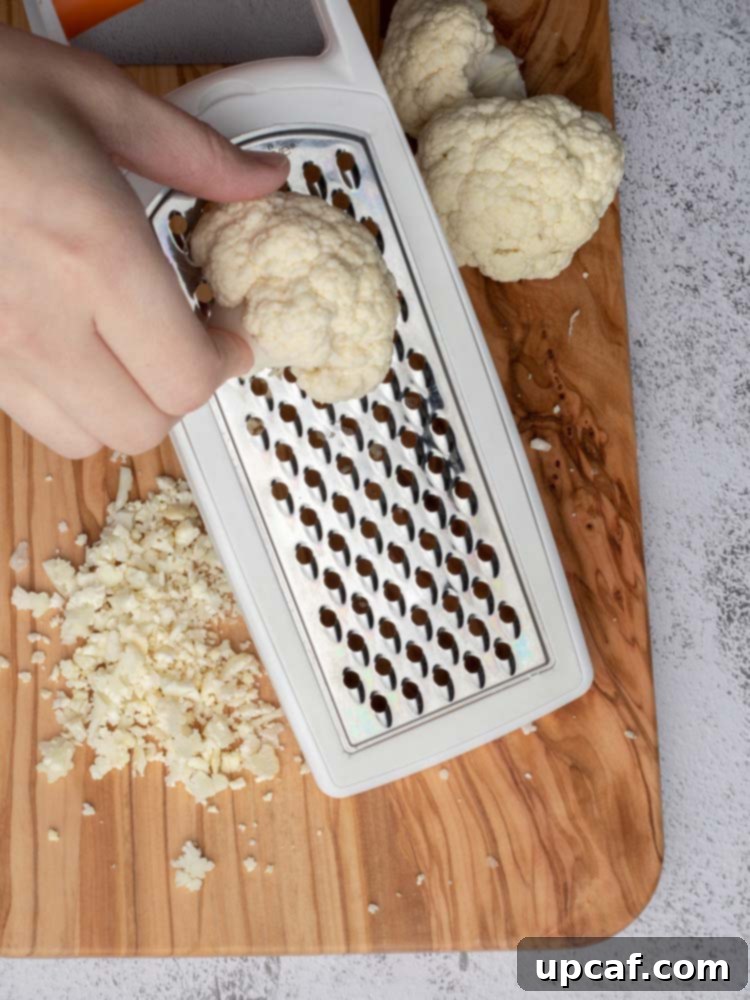
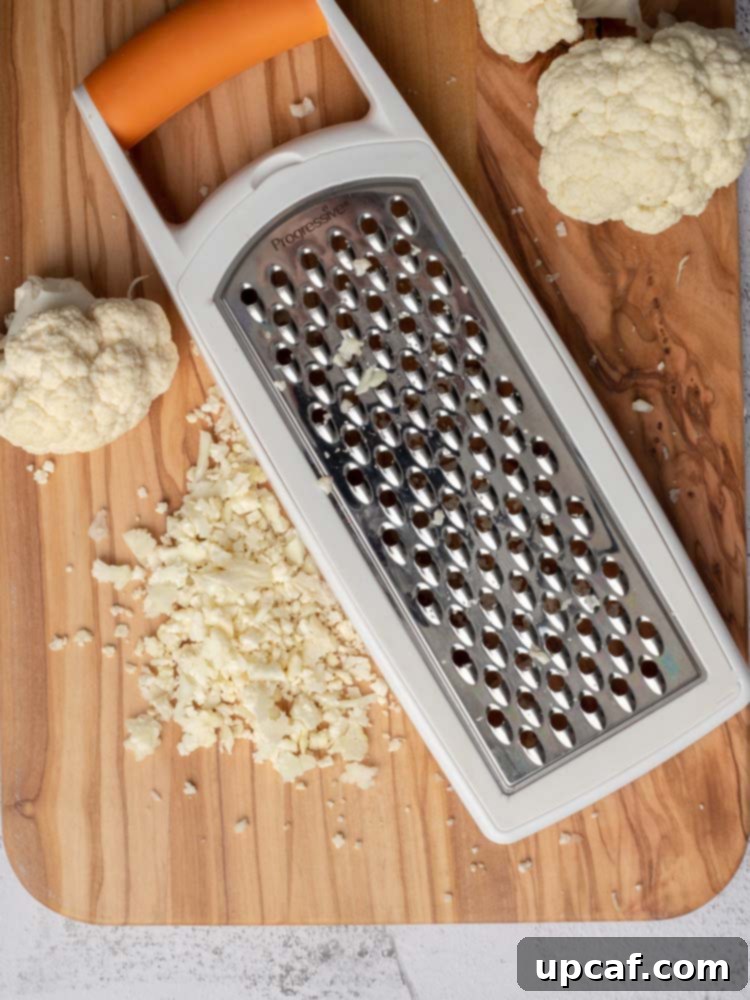
Method 2: Using a Food Processor for Speed and Efficiency
For a quicker and more effortless approach, a food processor is your best friend. This method is ideal for making larger batches and achieving a consistently fine texture.
- Initial Preparation: As with the grater method, begin by washing the cauliflower, removing the leaves, and trimming the core.
- Chop into Florets: Cut the cauliflower into approximately 1 to 2-inch sized florets. Smaller, more uniform florets will process more evenly.
- Batch Processing: Place the florets into your food processor, being careful not to overfill the bowl. For most standard food processors, filling it no more than three-quarters full is recommended. Overfilling can lead to uneven processing and overworked, mushy cauliflower. If you have a large head of cauliflower, it’s best to work in two or more batches.
- Pulse to Perfection: Secure the lid and use the “pulse” function. Pulse the cauliflower in short bursts, typically 3-5 seconds at a time. This technique is crucial to avoid turning your cauliflower into a purée. Continuously check the consistency; you’re looking for small, rice-like crumbles. Stop pulsing once the desired texture is achieved, usually after 10-15 pulses.
- Final Check: Once processed, transfer the cauliflower rice to a bowl. Quickly sift through it to identify any larger, unprocessed pieces. Return these larger pieces to the food processor and pulse them again until they match the rest of the batch.
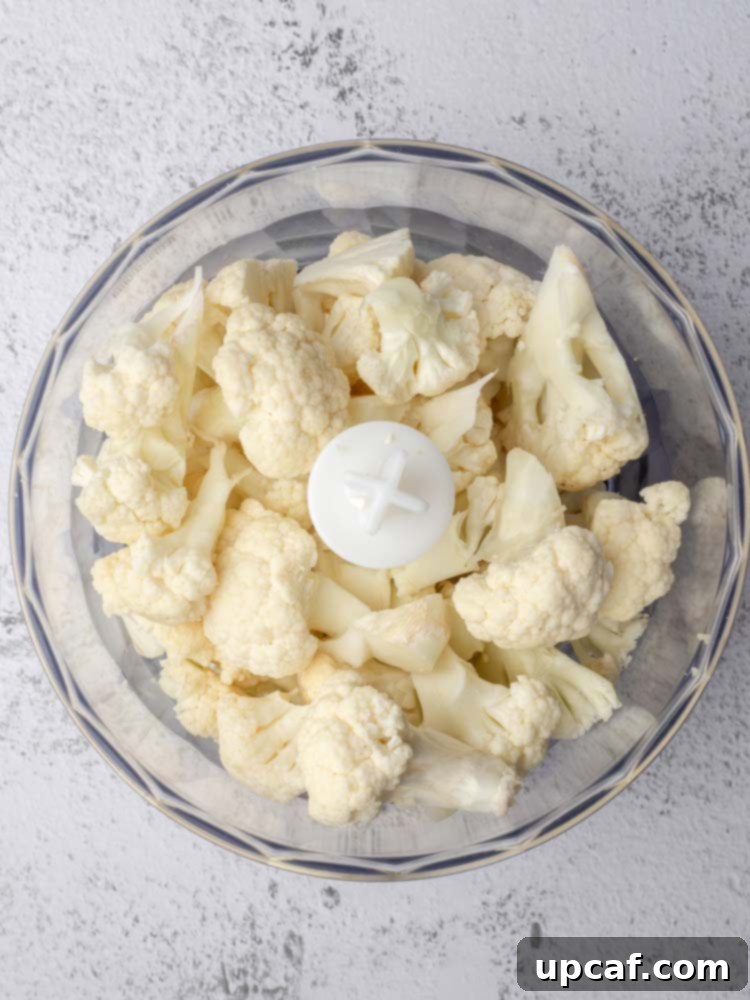
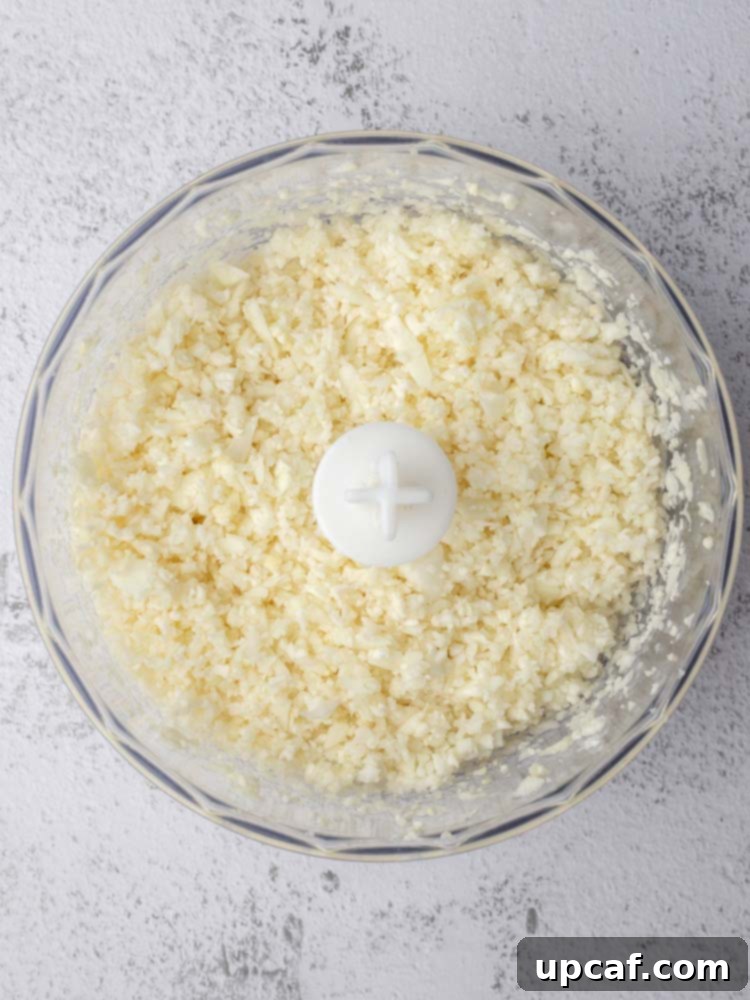
Cooking Cauliflower Rice: Achieving the Perfect Texture and Flavor
Once you’ve transformed your cauliflower into rice, the cooking process is quick and straightforward. The key is to avoid overcooking, which can lead to a watery and mushy texture. You want it tender-crisp, with a slight bite, similar to al dente pasta. You can cook it immediately after ricing or store it for later use.
Stovetop Sauté: The Most Popular Method
Sautéing on the stovetop is the most common and arguably the best method for cooking cauliflower rice, allowing it to develop a slightly nutty flavor and tender-crisp texture.
- Preheat Skillet: Heat about 2-3 tablespoons of olive oil or your preferred cooking oil (coconut oil or avocado oil also work well) in a large skillet or frying pan over medium heat. Don’t overcrowd the pan; cook in batches if necessary to ensure even cooking and prevent steaming.
- Add Cauliflower Rice: Once the oil is shimmering, add the freshly riced cauliflower to the hot pan.
- Season and Cook: Season with a pinch of salt and black pepper. Cook for approximately 5-8 minutes, stirring frequently to prevent sticking and ensure even browning. The cauliflower rice should become tender but still have a slight crispness. You’ll notice it soften and lose some of its raw crunch.
- Serve Immediately: Remove from heat and serve hot. For added flavor, you can stir in fresh herbs, a squeeze of lemon juice, or a pat of butter before serving.
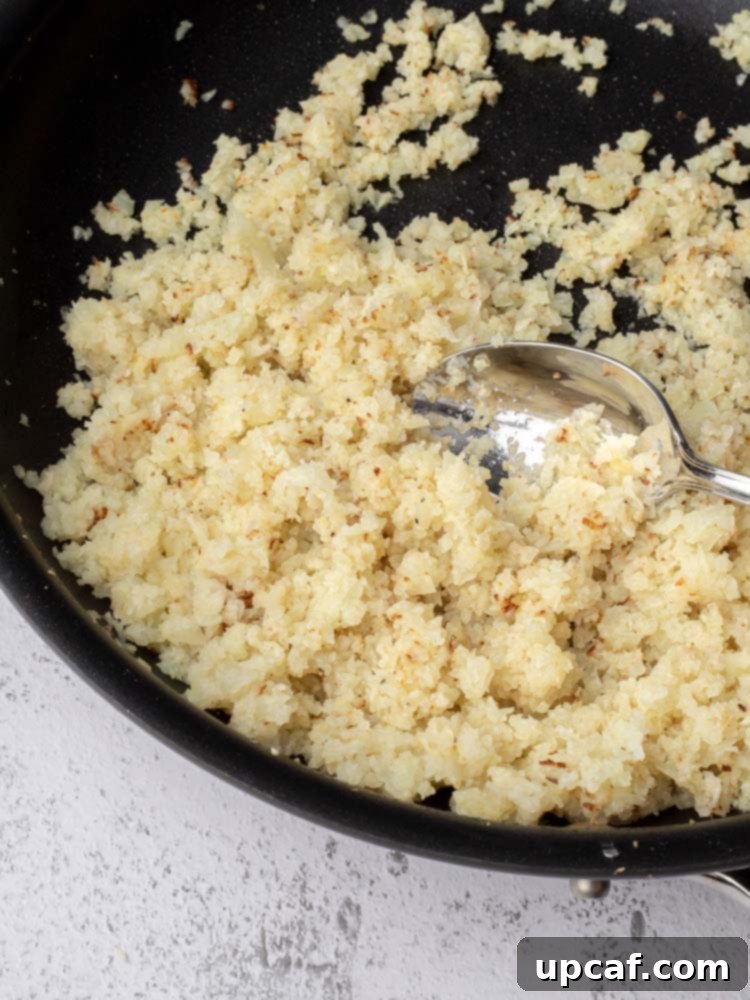
Other Convenient Cooking Methods
- Microwave: For the quickest option, place riced cauliflower in a microwave-safe bowl, add 1-2 tablespoons of water, cover, and microwave on high for 3-5 minutes, or until tender. Stir halfway through. This method is great for single servings.
- Oven Roasting: Spread riced cauliflower in a single layer on a baking sheet. Drizzle with olive oil, salt, and pepper. Roast at 400°F (200°C) for 15-20 minutes, stirring halfway, until tender and slightly golden. This method can yield a slightly drier, more toasted flavor.
- Steaming: Place riced cauliflower in a steamer basket over boiling water. Cover and steam for 5-7 minutes, until tender-crisp. This is a gentle method that retains moisture and nutrients.
Elevate Your Cauliflower Rice: Delicious Flavor Variations
The beauty of cauliflower rice lies in its neutral flavor, making it a blank canvas for countless culinary creations. Don’t be afraid to experiment with different seasonings and additions to complement your main dish:
- Garlic Herb: Sauté with minced garlic, fresh parsley, chives, or a blend of dried Italian herbs.
- Lemon Pepper: Finish with a generous squeeze of fresh lemon juice and a sprinkle of cracked black pepper for a bright, zesty kick.
- Asian Inspired: Stir-fry with a dash of soy sauce (or tamari for gluten-free), sesame oil, ginger, and a sprinkle of sesame seeds.
- Mexican Fiesta: Mix in chopped cilantro, a squeeze of lime juice, cumin, and a pinch of chili powder for a vibrant side.
- Curried Delight: Sauté with a teaspoon of curry powder, turmeric, and a splash of coconut milk for an aromatic and flavorful accompaniment to Indian or Thai dishes.
- Cheesy Goodness: Stir in a tablespoon of nutritional yeast (for a dairy-free option) or a sprinkle of Parmesan cheese at the end of cooking for a savory touch.
Smart Storage & Meal Prep Tips for Cauliflower Rice
Cauliflower rice is an excellent candidate for meal prepping, saving you time during busy weeknights. Proper storage is key to maintaining its freshness and quality.
- Freshly Riced (Uncooked): Store uncooked cauliflower rice in an airtight container or a resealable bag in the refrigerator for up to 3-4 days. Ensure it’s as dry as possible before storing to prevent spoilage.
- Cooked Cauliflower Rice: Once cooked, allow the cauliflower rice to cool completely before transferring it to an airtight container. It can be stored in the refrigerator for up to 3 days. Reheat gently on the stovetop or in the microwave.
- Freezing Raw Cauliflower Rice: Cauliflower rice freezes exceptionally well. Spread raw, riced cauliflower in a single layer on a baking sheet and freeze for about an hour until solid. This prevents clumping. Then, transfer the frozen rice to a freezer-safe bag, removing as much air as possible. It will last in the freezer for up to 3 months. When ready to use, you can cook it directly from frozen (it might require a few extra minutes of cooking) or thaw it in the refrigerator overnight.
- Freezing Cooked Cauliflower Rice: While you can freeze cooked cauliflower rice, its texture might become slightly softer upon thawing. Follow the same freezing process as raw cauliflower rice.
Frequently Asked Questions About Cauliflower Rice
Is cauliflower rice good for you?
Absolutely! Cauliflower rice is a nutritional powerhouse and a fantastic addition to almost any diet. It’s an ultimate health food hack for several reasons: it’s incredibly low in carbohydrates, making it perfect for Keto, Whole30, and Paleo diets. It’s naturally gluten-free, providing a safe and healthy grain alternative for those with celiac disease or gluten sensitivities. Furthermore, cauliflower is packed with essential nutrients, including high levels of Vitamin C (boosting immunity), Vitamin K (important for bone health), folate, and a good amount of dietary fiber, which aids digestion, helps regulate blood sugar, and promotes a feeling of fullness. Substituting traditional rice with cauliflower rice can significantly reduce calorie intake and support weight management goals while ensuring you get a robust serving of vegetables.
Can I freeze cauliflower rice?
Yes, absolutely! Freezing cauliflower rice is an excellent way to prepare it in advance for future meals. To freeze, simply place the freshly riced (uncooked) cauliflower into a freezer-safe bag or an airtight container. For best results and to prevent clumping, spread the raw riced cauliflower in a thin layer on a baking sheet and freeze for about an hour before transferring it to the bag. This flash-freezing technique keeps the grains separate. It will stay fresh in the freezer for up to 3 months. When you’re ready to use it, you can cook it directly from frozen (it might need a few extra minutes on the stove) or let it thaw on the counter or in the refrigerator before cooking as usual.
How long does cauliflower rice last?
The shelf life of cauliflower rice depends on whether it’s raw or cooked, and how it’s stored. In the refrigerator, uncooked riced cauliflower will typically last for about 3 to 4 days when stored in an airtight container. Cooked cauliflower rice, once cooled, can be stored in an airtight container in the refrigerator for up to 3 days. For longer storage, freezing is your best option. As mentioned above, both raw and cooked cauliflower rice can be frozen for up to 3 months, offering a convenient solution for meal planning and reducing food waste.
Delightful Pairings: Recipes to Serve with Cauliflower Rice
Once you’ve mastered this delicious and easy low-carb side, the possibilities are endless! Cauliflower rice is incredibly versatile and pairs beautifully with a wide array of healthy main dishes, adding volume, nutrients, and a satisfying texture. Here are just a few ideas to inspire your next meal:
- Korean BBQ Chicken Skewers: The light and neutral flavor of cauliflower rice perfectly balances the rich, savory, and slightly sweet notes of Korean BBQ chicken. It soaks up the delicious sauce beautifully.
- Mexican Shrimp Skillet: For a vibrant and zesty meal, pair cauliflower rice with a spicy Mexican shrimp skillet. The rice acts as a cooling base, complementing the bold flavors of the peppers, onions, and spices.
- Shrimp Taco Meal Prep: Turn your taco night into a low-carb feast! Instead of tortillas, serve seasoned shrimp and taco toppings over a bed of flavorful cauliflower rice for a deconstructed, healthier taco bowl.
- Grilled Salmon or White Fish: A simple yet elegant pairing. The delicate flavor of fish is wonderfully enhanced by lightly seasoned cauliflower rice, perhaps with lemon and dill.
- Chicken or Beef Stir-fry: A classic combination. Cauliflower rice provides a perfect low-carb base to absorb all the delicious stir-fry sauces and juices.
- Curries and Stews: From creamy coconut curries to rich lentil stews, cauliflower rice is an ideal absorbent side, allowing you to enjoy your favorite comforting dishes without the heavy carbs.
- Chili or Bolognese: Serve your favorite chili or meat sauce over a mound of cauliflower rice for a hearty and satisfying meal that keeps you feeling full without the grains.
I sincerely hope you enjoy discovering the incredible versatility and health benefits of homemade cauliflower rice. This simple yet transformative recipe is a game-changer for anyone looking to eat healthier, reduce carbs, or simply incorporate more vegetables into their diet. Give it a try, experiment with flavors, and share your delicious creations with friends and family!
If you try this recipe and love it, please consider sharing your experience! Your feedback helps others discover amazing healthy recipes. You can connect with me and share your culinary adventures on social media.

Homemade Cauliflower Rice
Mariam Ezzeddine
Cauliflower rice is an excellent, light, and healthy substitute for white rice, ideal for those seeking to reduce carb intake. It’s incredibly easy to make and perfectly suitable for a Keto-friendly diet.
10 minutes
10 minutes
20 minutes
4 servings
Ingredients
- 1 medium cauliflower head, cut into florets
- 3 tbsps. olive oil
- ½ tsp. salt
- Herbs or spices, optional (for flavoring)
Instructions
- Place cauliflower florets in a food processor and pulse until grated to a rice-like consistency. Be careful not to over-pulse, as this can make the cauliflower too fine or mushy.
- In a large pot or skillet, heat 3 tablespoons of olive oil over medium heat. Add the riced cauliflower to the pan.
- Sauté the cauliflower for a few minutes on medium heat, stirring occasionally. Then, reduce the heat to low, cover the pot, and let it simmer for about 5 minutes, stirring at least once to ensure even cooking. The cauliflower should be tender-crisp.
- Remove the pot from the heat and let the cauliflower rice rest for a couple of minutes before serving warm.
Notes
- For a fresh flavor boost, add some lime juice and chopped cilantro after cooking.
- Feel free to experiment with other spices or herbs like garlic powder, onion powder, cumin, or dried Italian herbs to customize the flavor profile to your liking.
Nutrition Information (per serving)
Calories: 134 kcal |
Carbohydrates: 7g |
Protein: 3g |
Fat: 11g |
Saturated Fat: 2g |
Sodium: 282mg |
Potassium: 430mg |
Fiber: 3g |
Sugar: 3g |
Vitamin C: 69mg |
Calcium: 32mg |
Iron: 1mg